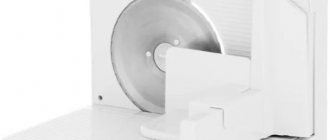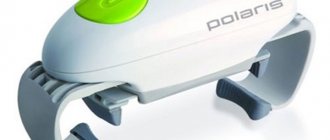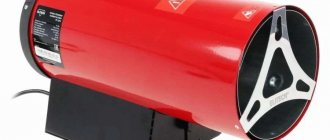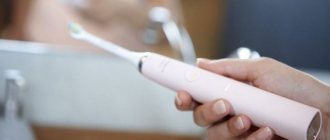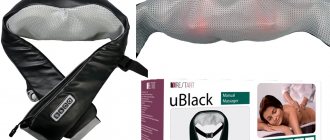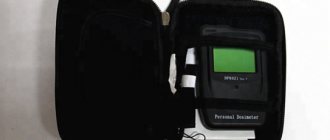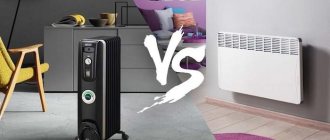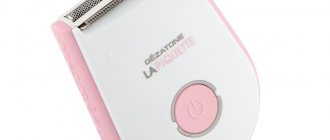What types of toothbrushes are there?
In general, all instruments for caring for teeth and the oral cavity according to the principle of action and functions are divided, in fact, into just 2 groups - these are mechanical, that is, the most common ones, as well as electric ones, which contain a battery that leads to the movement of the head or only her bristles. Electric ones, in turn, are divided into classical (the head simply moves), sound and ultrasonic (waves are added here), as well as ionic (negatively charged ions are additionally “included” in the work, which lead to effective destruction of plaque). They all differ from each other in the degree of stiffness of the bristles, the material of the bristles, and the size and shape of the cleaning head.
Any models can also be equipped with various and original additions:
- rubber insert on the handle,
- indicator bristles,
- use of silver ions,
- multi-directional or multi-level bristles,
- textured tongue cleaning pad,
- ribbed surface for gum massage.
Each type of teeth cleaning tool has its own advantages and disadvantages. Before making a choice, you should know what a sound electric device means, what is the principle of its operation, what are the differences from other types of dental care instruments, and are there any contraindications for use.
Working principle of an electric toothbrush
Reference! All electric devices for cleaning the oral cavity have a common feature: no matter how trivial it may seem, they are powered by electricity.
The source of electricity is AA batteries or rechargeable batteries. The latter can be charged with the charger included with the brush.
Battery-powered devices are more powerful and much more cost-effective than cheap models powered by disposable batteries.
However, they can cause inconvenience to avid travelers and overly forgetful owners.
Electric brushes are :
- mechanical;
- sound;
- ultrasonic.
Mechanical devices have a movable cleaning head driven by an electric motor.
In the process of cleaning the oral cavity, the bristles of the head make rapid movements that mechanically clean out plaque and stuck food debris .
It is worth noting! The nature of the movements depends on the cost of the product. The heads of the simplest models move in a circle, while the heads of slightly more expensive ones make rotational and translational movements.
In expensive models, the heads also pulsate. The more different movements the head makes, the more effective the cleaning.
The heads of cheap cleaning models make monotonous movements.
They can also be made from low-quality materials that are harmful to tooth enamel - cheap and overly hard or soft plastic.
Therefore, cheap devices often clean teeth poorly or damage the enamel .
Device and principle of operation
Such models date back to 1992. The device is a structure consisting of a handle with a built-in electric motor, a battery (or batteries) and a bristle head. The brush is called “sonic” because a microgenerator produces high-frequency waves, the vibrations of which cause the bristles to rotate and help clean plaque from teeth. Modern dental appliances of this type operate with a frequency of 500-1500 Hz and, depending on the model, are capable of 30-90 thousand vibrations per minute. Such a speed of movement, of course, is beyond the strength of a human hand.
For comparison! The number of rotations or vibrations that an innovative electric brush creates, we can do on our own with a regular hygiene product in at least 2-3 months. When brushing your teeth with a regular classic brush, you can achieve, with a lot of effort, only 250 vibrations per minute.
The bristles on the brush move in a circle, but some models use a combination of pulsating and reciprocating movements. The high amplitude of vibration creates an emulsion of saliva, water and toothpaste, which is able to penetrate into the spaces between teeth and hard-to-reach places. Thanks to this, not only a thorough cleaning of the enamel and interdental spaces occurs, but also the splitting of plaque. Many models are equipped with a timer that regulates the time spent cleaning the mouth.
What is the difference between an ultrasonic brush and an electric brush?
An electric toothbrush is a common and simple model that operates using an electric drive, which drives the cleaning head under the influence of current. The bristles perform reciprocating and pulsating movements, which eliminates plaque.
The ultrasonic brush is an improved model of the electric version. In ultrasonic devices, the movement of the bristles occurs due to the influence of ultrasound. Thanks to this quality, the models cope even with hardened plaque. In addition, such brushes inhibit the growth of pathogens.
A comparison with an electric brush shows how superior the ultrasonic model is to its technical characteristics, despite the general principle of operation. Dentists recommend its use to people suffering from dental diseases, increased sensitivity of enamel, and also wearing braces.
Ultrasound has a therapeutic effect on gum tissue, heating it by 1 degree, which has a positive effect on the blood supply to the inside of the tooth. An ultrasonic toothbrush, the reviews of which are positive, will become your reliable assistant.
Advantages of the models
Compared to mechanical models, sound ones have both pros and cons. Due to active movements, dynamic fluid flow and wave vibrations, the main advantages of modern models include the following:
- high efficiency in cleaning tooth enamel compared to any other models,
- effective removal of deposits even from under the gums, from very narrow gaps between teeth, that is, very deep cleansing of the entire oral cavity,
- ease of use,
- light massage effect on the gums,
- can be used for teeth with sensitive enamel,
- economical consumption of toothpaste,
- ergonomic design,
- allowed for use in children,
- reliability of the device and a fairly long service life.
This type of device is ideal for coffee and tobacco lovers. These products darken the enamel, while sound vibrations help lighten the tooth enamel by one or two tones. It is impossible to achieve such whitening with other, especially classic models.
Contraindications to the use of devices
The disadvantages include the high price, which, however, is compensated by long-term operation. Also, these models are not recommended for use by people with dental health problems.
Despite their safety and many advantages, brush models have a number of contraindications for daily use:
- pregnancy, especially in the first trimester,
- diseases of the oral cavity (hypertrophic gingivitis, periodontitis),
- high tooth mobility,
- surgical interventions in the oral cavity,
- acute and chronic inflammatory processes of tooth roots,
- demineralization of enamel,
- severe tooth wear,
- presence of a pacemaker,
- neoplasms of various types in the mouth,
- bruxism,
- defects of the dental neck.
It is not recommended to use products with a large number of fillings, implants, crowns, veneers, bridges and dentures. A high-frequency sound wave has a negative effect on artificial products, causing not only them, but also premature destruction of fixation compounds.
Pros and cons of sonic and ultrasonic electric toothbrushes
The advantages of electric toothbrushes over manual ones are obvious - they are much more productive and, therefore, more effective for oral hygiene, do not injure the gums and teeth, and, as a rule, have a number of additional service functions (timer, pressure sensors, etc.). Sonic electric toothbrushes have no contraindications and are recommended even for children.
The use of ultrasonic brushes has a number of limitations caused by the effect of ultrasound on the body. First of all, it cannot be used by people who have fillings, crowns, or implants, since high-frequency vibrations can cause disturbances at the boundaries between the enamel and the filling and shorten the service life of artificial products.
Read also: Which toothpaste does not contain fluoride?
There are suggestions that ultrasound is dangerous for women during pregnancy. Although there is no confirmed data on this, doctors still recommend refraining from using ultrasonic toothbrushes during this period. The use of ultrasonic toothbrushes is prohibited for people with a pacemaker.
Comparison of a sonic brush with a conventional mechanical one
The regular toothbrush has changed very little over its more than 2,000-year existence and also has its advantages. These include compactness and simplicity, acceptable (and one might even say very low) price, absence of contraindications, the possibility of frequent replacement, since even the cheapest option will be available to low-income people, low trauma to teeth and gums when used correctly, cost-effectiveness .
But despite all the advantages, a mechanical brush is significantly inferior to a sonic brush in the quality of cleaning teeth and gums. The advantages of sonic toothbrushes include high cleaning power with a minimum of movements. In fact, a person does not need to do anything - just move the brush along the teeth, and it will do everything on its own. Under the influence of waves, plaque splits even in hard-to-reach places. If the operating rules are followed, the device can be used for a long time without losing its functions.
Which brush is best for teeth?
Criteria for choosing a hygienic device:
- Type is a variety of models. If you want to keep up with the times, choose an ultrasonic device. If you are used to mechanical teeth cleaning, buy a manual device.
- The degree of hardness is determined based on the condition of the enamel, gums, and the age of the user. For adults with normal tooth sensitivity, medium or hard bristles are suitable, for children - soft, and for people with braces or dentures - extra-hard.
- Cost is determined by the manufacturer, availability for sale, functionality and completeness.
- Convenience – charging time, battery type, frequency of head changes, possibility of use by other family members.
- Technical parameters - number of revolutions, rotation speed adjustment.
- Additional functions - timer, tongue cleaning insert, head replacement indicator, silver ions, auto shut-off, teeth pressure sensor, etc.
- Dimensions of the working surface and length of the handle - the choice depends on the age of the user.
- Directionality is determined by the number and level of tufts in the bristles. There are hygienic, preventive and special types of brushes - for dentures or braces.
Sound or mechanical
These models differ in the principle of operation, so their comparison is not entirely correct. The choice of a sonic or manual toothbrush is based on personal preferences and product characteristics.
Advantages of a mechanical device:
- low price;
- availability;
- durability;
- no need to change batteries or attachments;
- you can buy several brushes with different hardnesses;
- Compact and easy to store.
- Homemade Caesar salad dressing
- First month of pregnancy
- Cake in a frying pan with condensed milk: step-by-step recipes with photos
Sound or electric
These products vary in price. The sound model is more expensive than the electric one. This is explained by a more modern operating principle - high frequencies for cleaning. Another difference between a sonic toothbrush and an electric one is the stationary working head. Only the bristles located on it rotate. The electric nozzle rotates, which often leads to injury to the oral cavity or plaque getting under the gums.
Sonic or ultrasonic
Models differ in vibration frequency. An ultrasonic brush is more powerful, creating about 100 million vibrations per minute, which significantly improves the quality of dental care. A high-frequency device cannot create a dynamic flow like an audio one. There are already combined models on the market that are equipped with generators to create medium and high frequency waves.
An ultrasonic brush ensures deep penetration of the paste and its absorption into tissues and tooth enamel.
Another advantage is its ability to destroy harmful bacteria. The sound model is cheaper. It is accessible to more people.
Sonic or electric toothbrush – which is better?
Both sonic and electric with a rotating head are both electric. They operate from a charged battery or batteries. The fundamental difference between a sonic brush is the frequency of movement of the bristles and the participation in cleaning waves (bristles + speed + waves). We can say that a sonic electric brush is a more advanced model of an electric one.
When electric brushes appeared, many began to abandon the classic models in favor of them - the rotational movements that an electric toothbrush makes provide good quality in cleaning teeth from plaque. But over time, it became clear that despite all its innovation, this method of daily care is still not 100% effective in a number of situations - food particles still settle between the teeth and become clogged under the gums. This forced scientists and developers to improve the electric brush model - this is how first the ultrasonic and then the sonic brush appeared (see the difference between the latter two below).
What makes a sonic toothbrush different is the presence of sound waves. The combination of high-speed rotational movements and sound vibrations contributes to the greatest effectiveness of hygiene measures. The softened plaque peels off the tooth and is washed away even from the most previously inaccessible places. For the oral cavity, devices of this type are less traumatic, and therefore preferable.
Important! Unlike a standard electric toothbrush, a sonic toothbrush has a larger list of contraindications - it cannot be used if you have dentures, braces, implants, or if you have electrical devices, such as pacemakers.
Why are toothbrushes called sonic and ultrasonic?
Ultrasonic brush: cleaning and prevention of oral hygiene
These names are arbitrary and they are not related to the ability of the brush to make sounds, but to its ability to vibrate. The sounds that we are able to hear have different wave frequencies - from 20 (low) to 20,000 (high) vibrations per second. Sounds with vibrations less than 20 per second (20 hertz) are called infrasounds, and those above 20,000 (20 kilohertz) are called ultrasound. Electric brushes that develop vibrations of the bristles in this range are called sonic, and brushes capable of developing vibration frequencies above 20 kHz are called ultrasonic. If we follow this principle, then manual toothbrushes can safely be called infrasonic, since we physically cannot provide the brush with more than 4 vibrations per second (4 Hz) using mechanical movements. Having understood the terms, you can move on.
Difference between sonic and ultrasonic models
Both devices work virtually similar to each other, but an ultrasonic electric toothbrush produces ultrasonic waves that are longer in length. Compare, in sonic brushes there are about 30 thousand sound vibrations per minute, and in ultrasonic brushes this number starts from 100 million. Increasing the frequency and speed of rotation by several orders of magnitude has both its advantages and significant disadvantages.
Thanks to the increased power, toothbrushes with ultrasound acquire a number of advantages; the bristles rotating at ultrasonic speed carefully remove soft deposits and destroy harmful microorganisms; penetration of ultrasound to a depth of 4 mm helps remove plaque in places inaccessible to other types of devices; ultrasonic waves can have a therapeutic effect on the periodontal groove, shallow periodontal canals, interdental spaces, high-frequency ultrasound helps to release healing components from toothpaste, thereby helping to strengthen the enamel.
Ultrasonic models perform antibacterial and disinfecting functions and stimulate metabolic processes. Their action can be compared to a portable scaler, which periodontists use to treat gum disease and clean plaque. But along with the fact that such enhanced hygiene procedures are not carried out every day in a dental office, ultrasonic brushes, when used daily, can in some cases cause harm, especially in the presence of oral diseases. At a high oscillation frequency, the amplitude of movement of the bristles becomes extremely small, so the necessary sweeping movements are not carried out, as is done in sound analogues. Therefore, sound devices are still considered more effective.
Key differences between electric and ultrasonic models
Ultrasonic brushes have appeared on the market relatively recently. Their technical characteristics are similar to electrical ones. The key difference is that in such models the movement of the bristles is supplemented by ultrasonic vibrations. This technology effectively removes plaque that remains on smokers, coffee, strong tea, and red wine drinkers.
A wide range of functions guarantees perfect oral cleanliness
In addition, the use of ultrasonic brushes stimulates the process of destroying pathogens, so plaque does not form after cleaning, and fresh breath lasts longer.
Ultrasound destroys bacteria, improves blood circulation, increases local immunity
Regular use of such tools to clean the oral cavity has a therapeutic effect on the gums. At the same time, blood circulation improves, local metabolism and immunity are enhanced. The use of high-quality brushes with ultrasonic technology normalizes redox processes, so beneficial substances in pastes, gels, and powders are better absorbed. In addition, such cleaning helps relieve inflammation in the presence of certain diseases.
Ultrasound device
Electric toothbrushes also have a wide range of capabilities, guaranteeing high quality cleaning, comfort, and delicacy. The difference between these brushes is the absence of ultrasound when cleaning the oral cavity. Their peculiarity is the presence of various types of movements, which guarantees penetration even into hard-to-reach places.
Electrical devices
Thus, the main difference between a sonic toothbrush and an electric one is the additional effect of ultrasound on tissue. People with a healthy oral cavity are recommended to give preference to electric devices, and for the care of an oral cavity that contains orthodontic structures, it is better to use ultrasonic ones. This is explained by the fact that ultrasound is able to remove dirt even from hard-to-reach places near the crowns, as well as improve the condition of the gums.
Best sonic toothbrush
Panasonic and Philips have high ratings in the dental products market. The first provides models with a standard set of functions for both home use and travel. Panasonic EW-DE92 is also available, equipped with an ionization function. Prices for electric brushes of the sonic type start from 7 thousand rubles. The second company (Philips) offers an impressive range of devices with a wide variety of functions, the cost of which ranges from 6-13 thousand rubles.
The manufacturer CS Medica produces reliable models with good performance indicators and several cleaning modes, while the price is an order of magnitude lower than that of the leaders. Sound devices from Omron, Xiaomi and Hapica have proven themselves well. All devices operate on the same principle, but differ in cost, power, functionality and design.
Types of toothbrushes
- Manual – manual cleaning by moving the working head along the enamel surface. The result depends on the properties of the paste and the degree of stiffness of the bristles (soft, medium or high). The first model was released in 1885. Brushes with nylon bristles appeared in 1938.
- Electric – brushes teeth using a motor that transmits energy to the nozzle. In a minute, the brush makes 5-18 thousand movements. The first model appeared in 1959.
- The sonic toothbrush is a successful upgrade from the electric model. The motor generates current, which is converted into sound vibrations - up to 30 thousand / min. Time of appearance: 1992
- Ultrasonic is a modern device for oral hygiene. The work is based on the principle of high-frequency oscillations - about 100 million per minute. Date of appearance on the market: 2007.
Articles on the topic
- Nimesil - instructions for use. How to dilute nimesil powder
- Cook something tasty and unusual: recipes
- Coagulogram - what kind of blood test is it and how to decipher it
How to choose a sonic toothbrush
Stores today sell a wide range of teeth cleaning tools to suit every taste and budget. But before choosing a model, you should visit a dentist who will diagnose your oral cavity. After the examination, the specialist will be able to give recommendations on choice, taking into account the patient’s age, oral health, and the presence of contraindications. Before purchasing, you should also familiarize yourself with the technical characteristics, advantages and disadvantages of the selected model. Important points to note are the following:
- the number of vibrations of the fibers - the more there are, the higher the quality of cleaning,
- charging type: a device with batteries is not only more convenient, but also much more economical than analogues with batteries,
- hardness: it is best to pay attention to models with medium hardness, in this case the risk of damage to the enamel and mucous membrane is minimized,
- head shape: smooth and round with synthetic hairs is considered the most preferable,
- manufacturer: by giving preference to trusted companies, you can be sure of the high quality and reliability of the device.
When purchasing, you must remember that cost is not a priority indicator. You should choose based on your dentist’s recommendations and your preferences. It would be a good idea to read the reviews of those who already use such models. Most often, the price is inflated due to the presence of various functions that in reality turn out to be not very necessary. It is best to buy from retail outlets that specialize in selling such goods. In addition, it is in such stores that they give a long warranty on their products.
For your information! Sonic electric brushes can be used by children over three years old, but when purchasing, you need to focus on devices designed specifically for children of this age.
How to use a sound device correctly
To avoid unwanted consequences when using a sonic electric brush, you must follow simple recommendations:
- for the purpose of habituation, increase the rotation speed gradually over 14 days,
- to prevent the spread of bacterial microflora, removable nozzles must be changed every three months,
- The greatest effect is achieved by brushing your teeth twice a day,
- use a small amount of paste,
- The duration of the procedure should not exceed 3 minutes.
The sequence of actions when brushing your teeth will be as follows:
- check the functionality of the device, it must be connected and charged,
- mentally divide the jaw into three parts, sequentially treat each zone for about 30 seconds until the timer ends. You cannot press on the device, that is, brush your teeth without effort - it will do everything for you, you just need to move it along the row,
- during manipulations, clean hard surfaces with a slight grip on the gums,
- after completing the procedure, turn off the device,
- rinse your mouth, washing away food particles and plaque removed from teeth,
- Rinse the brush head well under running water.
When the brush is turned on, the bristles move independently, so there is no need to actively move the brush while cleaning the oral cavity.

